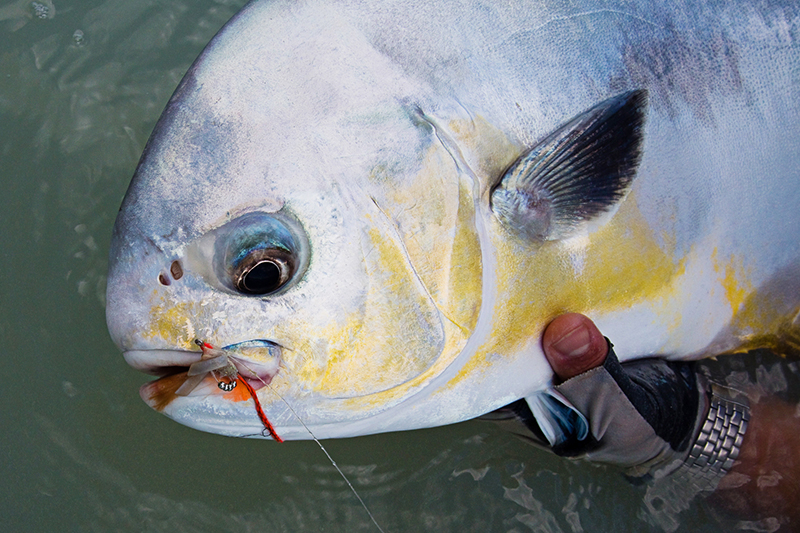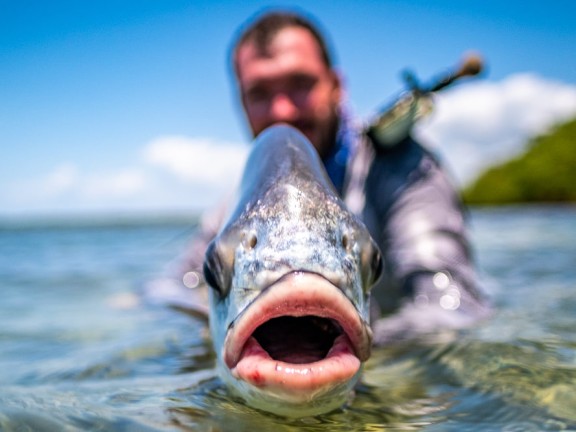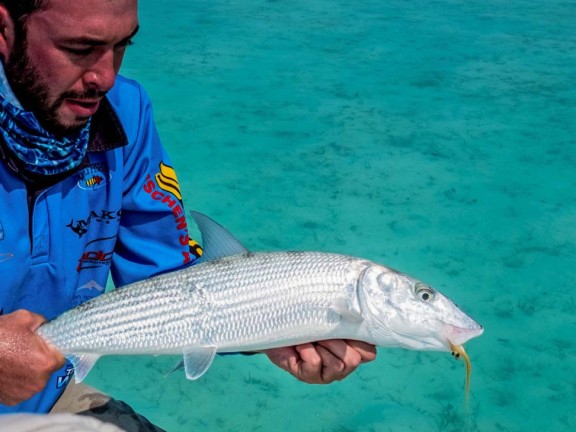Cuba might be the best place in the world to catch your first and largest sickletail.
It had been a long tough week on the flats. Back-to-back cold fronts replete with a savage easterly wind had churned the crystal waters of Cayo Cruz into a milky soup. Overhead, the towering thunderheads had crowded out the sun, further conspiring to make sight-fishing all but impossible. All week my guide Raffa and I stuck stubbornly to our task, fly fishing for permit, and despite those wretched conditions, we’d had a couple of shots—gut-wrenching heartbreakers when a permit suddenly appeared, right in front of us, materializing from nowhere, and was already fleeing before I finally made it out. Somehow I managed to hook a fish, but tragically, it came unbuttoned, right at the boat.
On the last day, as I throw open the big shutters on the windows of old Casona, I am met not with rain and wind, but a clear, sparkling sky, shot through with the rosy hues of the dawn. My old friend Tim and I squeeze into the old Russian truck, and bump down a rutted tarmac, past sugarcane threshers and field workers who are waving and laughing as they stroll down the main drag to another long day in the fields. We turn off the highway and head north. I’m upfront with Lucio, our driver, and I grin as he lights up a Popular and absentmindedly hums along to the incongruous old Adele CD that serenades us to the dock and back each day. I cadge a smoke and as I wind down the window, I catch the warm, salty air wafting off the flats. As we cross an old causeway, we can see that the wind has died and vast flocks of flamingos are tip-toeing in the shallows. Better yet, the spring tides have washed the sand suspension out of the water, rendering it clean and clear at last. As we pull up to the dock, I see that our dear old friends, Raffa and Nelson, are already preparing the skiffs. Today, at last, we have a chance.
Tim and Nelson head west to Cayo Megano. Raffa and I head to a spot that I love—the vast flats east of Punta del Este. The first hour is slow. The tide is only starting to rise, and the Punta del Este flats are just a little shallow to accommodate the big permit that like to feed on its endless white canvas. We push across to Roca y Piedra and fish the outermost edge, close to the ocean, most likely the best place to ambush a big permit as it arrives to forage in the shallower water. We find a nice long broken line of rock and turtle grass, and pole gently along its edge. Only a few rays glide across the flat and they are alone.
Then, suddenly, Raffa is animated. “There, Mac! Look! Eleben! Tailing!” I start to point my rod to 11 o’ clock but already I have it—a big black sickle tail is wagging lazily in the early morning sun, rooting out a crab from the rocky seam that divides the vast white swathes of sand.
The wind has died to nothing, and I wait breathlessly as Raffa gently pushes us in range. As he stops the skiff, there is a faint crunch from the pole as it buries in the coral beneath the powdery sand, and the tail slides under the surface. “Puta!” Raffa hisses. But just as I am about to echo his curse, the tail is suddenly up again, the fish unaware of our presence as it resumes its early morning feed.
Responding to the flat calm, I take a chance, quickly biting off the Sideswiper crab and replacing it with a little tan-colored Alphlexo—a pattern that makes less splash on the glassy, mirror-bright surface. The fish is still happily grubbing in the sand and broken coral, and I start to line up the shot, lengthening the line and then sending the fly arcing out over the water. I feather its fall, and the little crab imitation lands just to the left of the fish. I let it drop and then give it a gentle strip to grab the permit’s attention. At first, the fish seems unaware of my offering, but then, in a magical moment, it slides purposefully over to the fly and we watch as its tail arcs up high into the air. I draw the line smartly back and, feeling resistance, set the hook with a sharp, jabbing strip-strike. The next few moments are fraught with anxiety, as I watch the running line shoot up off the deck. Soon, my precious permit is on the reel and we are in business.
Battling a permit is never fun. I’ve watched big fish—that I thought were beaten—tip up in a heartbeat and rub my fly out of their mouth, leaving me inconsolable. Fishing is supposed to be fun, but this is somehow too important to enjoy. I’m often reminded of the old Liverpool soccer coach Bill Shankly’s famous quote: “Some people think football is a matter of life and death. I assure you, it’s much more serious than that.”
Permit fishing is the same: After a long battle and a tense, nearly unbearable end-game, comes that special moment that permit addicts know. That moment when a guide’s hand closes around the wrist of a fish’s tail and an angler senses relief and elation, a feeling that assures all those long hours were undoubtably worth it.

We gaze down at the fish—24 pounds of opalescent perfection, those deep flanks splashed with a vivid lemon yellow. The permit seems to gaze up at me with a big black eye. Raffa cradles it under the water and gently removes the hook. I get a childish rush. We make some quick pictures and then I gently nurse the fish until I feel its strength return. I take one last look at that big, sickle tail and then, with a flourish, it kicks away from me and disappears into the pellucid water. I’m shaking a little, like always. “Give me a smoke,” I say to Raffa.
“You want to try for a slam?” says Raffa as he lights me a Popular and passes over an icy Crystal from the cooler. I catch his eye and he’s grinning because we both already know the answer “No, signor!” I smile at my old friend and say, “Let’s go catch another.”
Cuba offers some of the very best fly fishing for permit, anywhere in the world. For many years, the ongoing spat between the United States and Castro meant that Brits like me had the place pretty much to ourselves. Even now, with the recent easing of restrictions, Cuba has enough vast flats to offer wonderful permit fishing for all.
I have fished all of Cuba’s major permit fisheries, and I particularly favor these three.
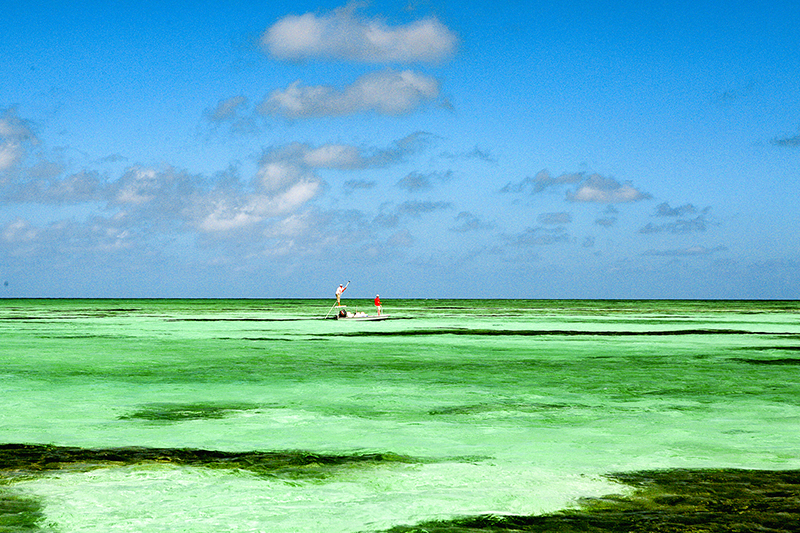
Jardines de la Reina
I’ve fished at JDR for over 20 years, and it is a very special place. It offers 840 square miles of pristine flats that remain just about as wild and untouched as they were when Christopher Columbus splashed ashore and named them for Isabella over 500 years ago.
I caught my first permit here with another old friend, Bemba, on May 25, 2009. After we’d finished celebrating, we managed to add a tarpon, a bonefish and a snook, thus completing the first super grand slam ever recorded at this fly fishing mecca. It’s a day I will never forget.
JDR is a first-class permit fishery and offers fish of high average size. Perhaps the biggest problem at JDR is the presence of other species—it’s often extremely difficult to keep fixed on the permit when big, mirror-scaled tarpon are rolling all around and vast schools of lithe bonefish are tailing in the shallows. If you have the self-discipline to target permit, there is a huge diversity of habitat to keep you entertained and constantly thinking. On the ocean-side, in the choppy waters around Faro and Mar Y Flores, jagged coral flats mean that crabs are the main forage and it pays to throw something sizable, like a Sideswiper or the excellent Strong Arm Merkin Crab. On the inside, you’ll find beautiful sand flats at Las Auras and Cayo La Lisa where smaller shrimp imitations, like the all-conquering Avalon Shrimp, are more effective. The flats shelve sharply on the north shore, but the white sand means that big permit are easy to spot even in three or four feet of water. For these flats I developed a tungsten-beaded version of the Avalon Shrimp that sinks quickly into the permit’s eyesight. It caught me three big permit here with yet another very special friend and fly fishing mentor, Coki, in 2019. One of the most fascinating features of JDR is that the fish often fixate on large, black urchins, grazing on them like a cow eats grass. I’ve given up throwing perfectly serviceable urchin imitations, and now just try to drop a big Avalon or some crab pattern right on their noses.
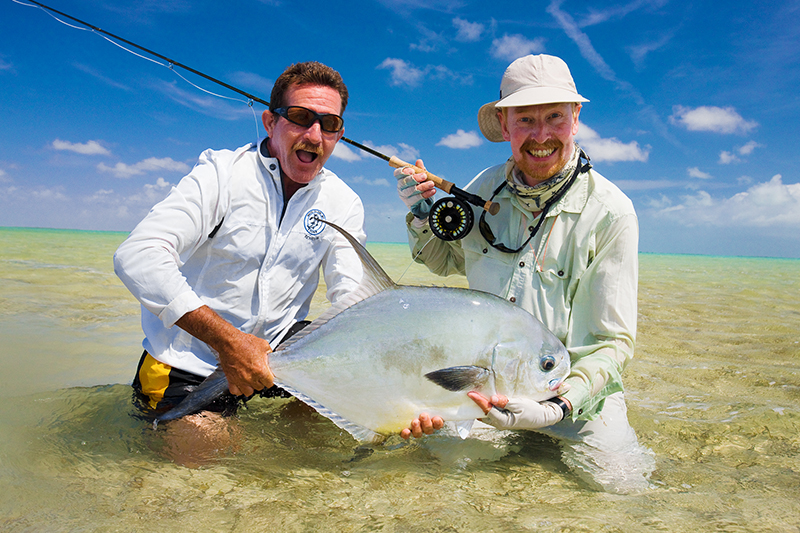
Cayo Largo
Cayo Largo is the birthplace of the Avalon Shrimp. This remarkable fly is the brainchild of my old friend Mauro Ginevri, who ran the lodge here for many years, and became almost obsessive in his quest to imitate the permit’s favorite forage item on the sand flats. After about a year of study, he came up with the Avalon, and it is an absolute game-changing pattern for Cuban permit. Unlike crab patterns, you can strip the Avalon to imitate a shrimp, and this means that the permit simply doesn’t get a good look at it. Let’s face it—the Avalon is just a load of fluff and steel. I love this fly and I’ve caught more permit with it than any other pattern.
Cayo Largo has huge numbers of permit, and of all of Cuba’s locations it is probably the easiest place to successfully kick-start your permit-fishing career. Crucially, the vast sand flats here offer the perfect habitat to find a fish riding shotgun with a stingray. This is, undoubtedly, the easiest way to catch a permit, especially if there are two or more permit with a ray.
Fish follow rays to feed on the forage they kick up. At that time permit are most vulnerable to fly-fishers. First, they are by definition feeding. That’s got to be a good thing. Second, the rays tend to kick up a lot of sand as well as food, so it is harder for the permit to examine your fly or see your leader material. Finally, rays are much easier to spot than permit, so you can see your quarry a mile off. This offers plenty of time to plan an ambush and line up your skiff and make the shot as easy as possible. Which is much better than being in a fevered rush when you suddenly see a big fish that is only 10 yards from the boat.
I once shared a golden week with William, Mauro’s head guide at Cayo Largo and one of the most talented guides I have ever fished with. Unlike many of my favorite firecracker Cuban permit guides, William retains a perpetually easy, relaxed demeanor, probably because he can spot a big black ray at 300 yards and set you up with a nice easy downwind shot. During one special week, I managed two super slams and one grand slam at Cayo Largo with this amazingly talented guide.
While Cayo Largo does have the occasional big fish, if you are after a real monster, you really want to head north to Cayo Cruz.
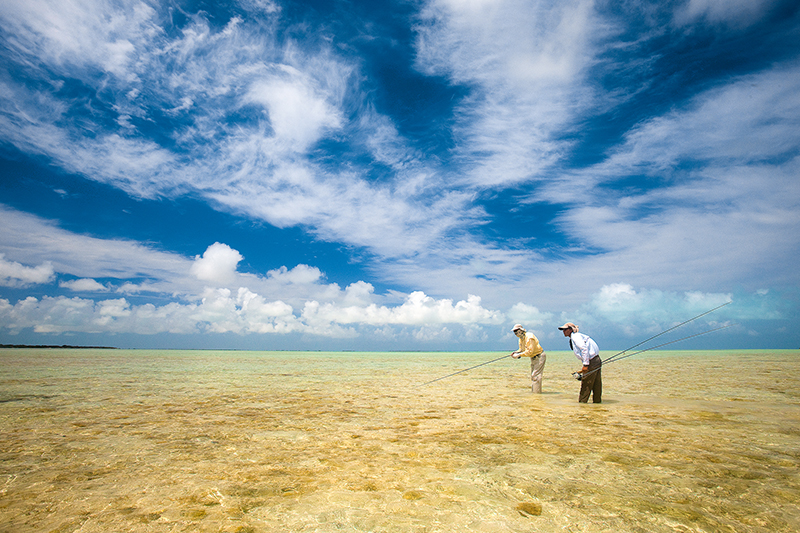
Cayo Cruz
I first fished Cayo Cruz in 2010 with my great friend and fellow permit nut Tim Marks. We fished with a novice guide “Gorgeous” George, who fell off the poling platform four times in one morning. It was a day of high comedy, but we could see the potential. We came back a week later, and I met up with a man named Raffa, who became another great friend. We caught a big, beautiful permit, and Tim and I had one each the following day.
Cayo Cruz lies adjacent to the Bahama channel, and the big fish that cruise out of deeper water here are sometimes astonishingly big. On more than one occasion the guides have mistaken them for tarpon. I believe that I have seen 50-pound permit here. The fish often hang with stingrays and they can occasionally be seen sipping juvenile white crabs from surface grasses and sponges. At such times, they can be caught with floating crab patterns, although I have had more success with small shrimps and lightly weighted Alphlexo crabs.
There are a few tarpon and some real trophy bonefish here, but it is primarily a permit destination. My friend Tim has caught two fish of well over 30 pounds here, and I lost a fish that my guide reckoned was nearer 40—it rubbed the fly out on the seabed after a 30-minute fight. These permit are as big as any in the world. They can be extraordinarily tough to catch and they will break your heart any number of times. But keep at it, and keep telling yourself that, like all creatures, permit have to eat.
Sometimes they do.
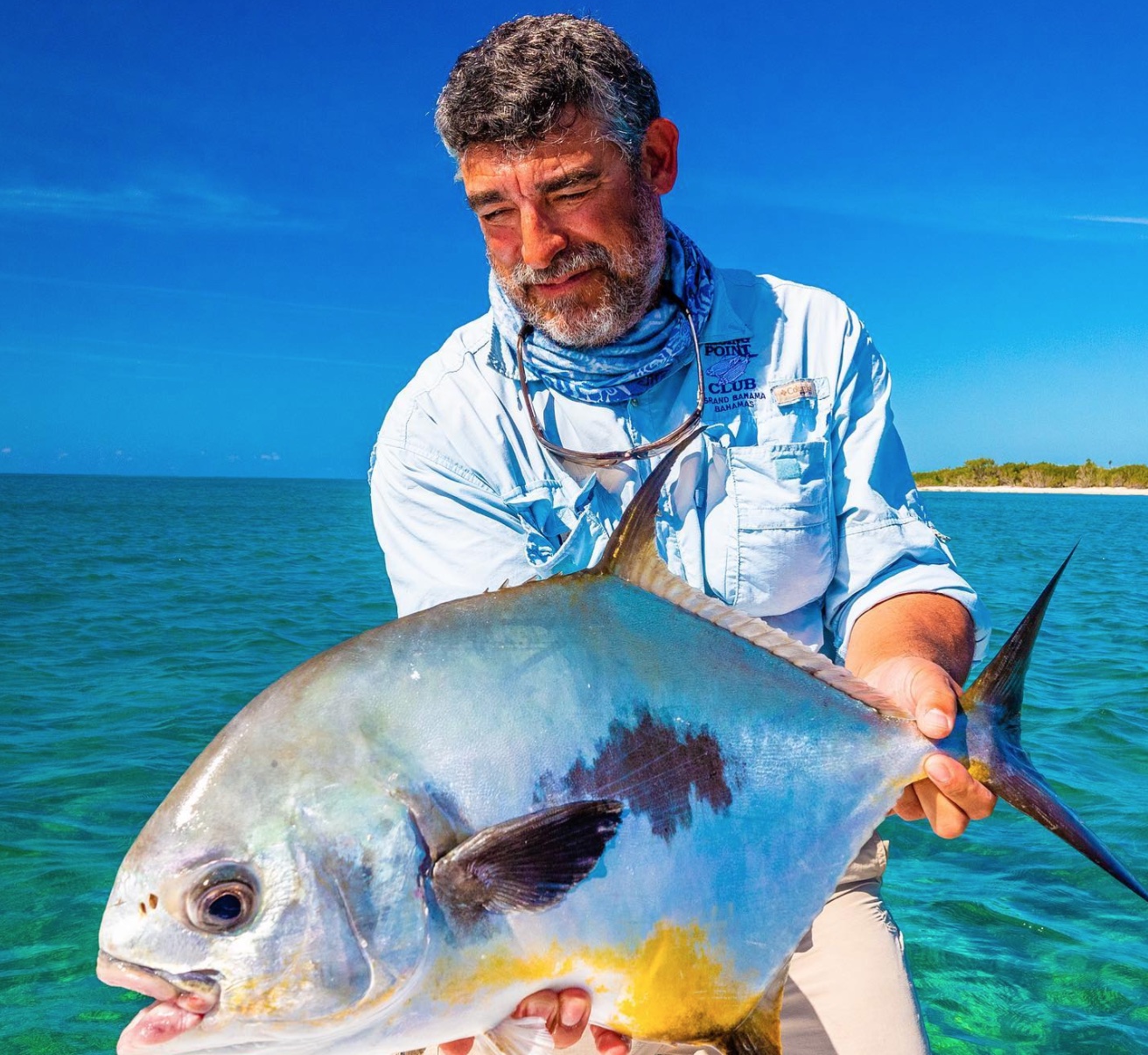
Matt Harris
Matt Harris is a globetrotting photographer who catches fish wherever he goes. Check out more of his work on IG @mattharrisflyfishing
